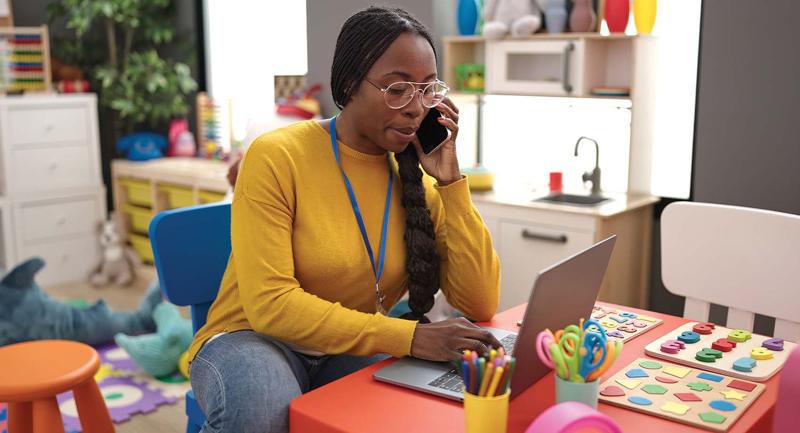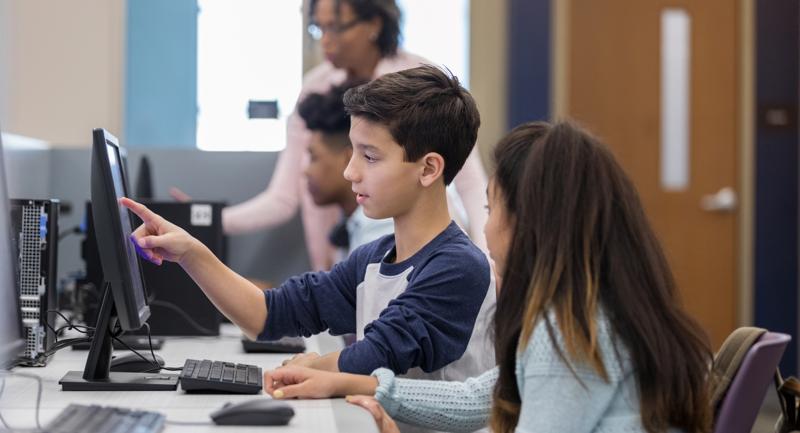Aaron Sams's son has been on an origami kick lately. Every day, the 8-year-old comes home from school and hops on YouTube to learn how to make a new origami shape. The Sams house is filled with countless ninja stars, flying discs, animals, boxes, and other tiny paper creations.
Contributing to the 6 billion hours of video watched on YouTube each month, Sams's son represents a generation raised on screen time as early as infancy. "He could text before he could write at age 4, and he began accessing video content on his own at age 7," says Aaron Sams, an educator and coauthor of Flip Your Classroom: Reach Every Student in Every Class Every Day.
According to a 2010 Kaiser Family Foundation report, children ages 8 to 18 spend nearly 7.5 hours each day consuming entertainment media—listening to music, watching TV and movies, surfing online, reading, etc.—often simultaneously. Caught between the pull of multitasking and passively absorbing the information being relayed, students often struggle to scratch the surface of what they are viewing, especially when it comes to video.
To make the shift from vegging out to tuning in for learning, students must develop the skills to critically view videos, listen to them with purpose, and have meaningful academic conversations about their content.
Quality and Relevance
Before teaching students how to actively engage with video, you need to find the right video to support your lesson. Sourcing an online video that is both entertaining and meets your educational criteria can be daunting. Catlin Tucker, a high school English teacher and author of Teachers' Guide to Using Videos, published by MindShift, recommends separating videos into two categories: instructional and supplemental. Instructional videos could "serve as an alternative to direct instruction," says Tucker, and they are helpful for delivering information on a topic or explaining complex concepts.
These videos are especially "efficient and effective" in teaching "nitty-gritty" content to students, such as math equations, says Sams, but he believes that "big concepts, at least in science, are better discovered through inquiry."
Supplemental videos, on the other hand, "complement in-class work to pique interest, drive inquiry, motivate exploration and problem solving, expand on concepts, or offer an alternative explanation," writes Tucker. When teaching a difficult concept, Tucker anticipates that her students will struggle with their homework, so she provides them with a link to a supplementary video that elaborates on the concept or explains it differently.
What qualifies as an effective video in either category can be "wildly different," depending on a teacher's needs. In the guide, Tucker outlines questions to consider when assessing the quality of a video, including "Does the video identify a clear topic to be discussed, a question to be answered, or an objective to be reached?", "Is the content accurate?", and "Is there a balance between the educational content and entertainment?"
Length is also important. Video is great for "quick bursts of information," says Sams, who abides by the one-minute per grade level rule of thumb. An appropriate video for a 6th grade class, for example, would be six minutes or less.
Video should not only fulfill an educational purpose concisely, but also include common language that connects with students. Sams advises teachers to keep three criteria in mind when selecting a video:
- Alignment to standards or learning objectives
- Choice of vocabulary
- Context
When previewing a video, check that the vocabulary terms match up with the terms being taught, especially in science and math, and that the video is contextually relevant, says Sams. When he taught chemistry in Colorado, the altitude affected "everything from the chemistry lab to the way you cook your food" (even water boiled at a different temperature). In the instructional videos he produced, Sams explained concepts in a way that directly applied to his students and their experiences—but that weren't as relevant to students living at sea level. Be mindful of "those kinds of variances on content that is universally applicable," he says.
Listening with Purpose
Identifying which videos to show is the first challenge; teaching students how to view them critically is the second. The Common Core Speaking and Listening Standard 2 requires students to thoughtfully "analyze the purpose, credibility, and accuracy" of the media that they are consuming, explains Erik Palmer in Teaching the Core Skills of Listening and Speaking (ASCD, 2014).
"We have to expand our definition of listening to include media literacy," Palmer contends. Students are often "clueless about the media techniques used" in a video, which can obscure their understanding of the message being portrayed.
To effectively critique a video, students have to be actively engaged with it; that means they have to learn how to listen with purpose. Palmer recommends having students view videos multiple times, prompting them to notice something different with each screening. Kid President's YouTube video, "A Pep Talk from Kid President to You," is an easy choice for this activity. Before each screening, Palmer suggests giving students the following purposes:
- Screening 1: Look for the main ideas and write down the three that really stood out to you.
- Screening 2: Look for the ways the ideas were supported.
- Screening 3 (with the sound off): Notice the images and scene selections. How do they contribute to the message?
- Screening 4: Focus on the soundtrack. How does the music affect the message?
- Screening 5: Focus on the technique of the speaker. What does he do to make the talk engaging?
"Even a science video about cell division should be treated this way," Palmer continues. "In the first screening, describe the process; in the second screening, describe how the images helped you understand the process."
"You want students to grasp that listening is not the same thing as passive hearing: it is purposeful, active, and interactive," he concludes.
Tucker offers additional activities to get students engaged around a video. She suggests showing a video clip that "asks a question, presents an interesting situation, or ties the topic to a real-world issue" and pausing it at a critical point to allow students to collaborate and make predictions about what will happen next.
It is essential that students learn how to "have an academic conversation" about a video, Tucker says. For classrooms with access to 1:1 technology, videos (longer than five minutes) can be paired with a backchannel tool like TodaysMeet so that students can ask questions or share insights with classmates in real time. Tucker recommends extending these conversations with an online discussion platform like Collaborize Classroom to allow students the time and space to explore video content in more depth. Those conversations can be woven back into the classroom with small-group discussions for deeper learning, she notes.
Providing discussion questions and teaching students "how to take ownership of that discussion and effectively drive it forward" can pave the way for more substantive discourse around a video, says Tucker.
"Most young people do not know how to have an academic conversation about complex topics. They text, tweet, update profiles, send Snapchats, etc. Those brief informal conversations have their place in our lives as social beings, but they are not 'academic' conversations."
To reverse this tendency, Tucker might ask students to read an excerpt from The Canterbury Tales and answer the question, "What elements of courtly love do you see evidence of in 'The Knight's Tale' parts 1 and 2?" After they post their response to the online discussion board, students reply to two peers' comments, "making connections, asking questions, and building on ideas shared." The same collaborative activity can be achieved with a video clip, Tucker says.
The Opposite of a Good Video
Although it is clearly a powerful learning tool for a generation that's wired to watch, video can lose its appeal when it is overused in the classroom or lacks a real purpose. "As you plan your lesson, ask yourself if a particular topic or concept is best taught through inquiry, discovery, or direct instruction," says Sams. "Not everything should be taught through video, so be strategic about why you're using the medium to deliver a particular topic."
Also, try not to use video as "filler," which is something Sams admits to doing early in his career. "I would find some video in the library that sort of pertained to a topic I was teaching, pop it in, and hope for the best." When that approach fell short, he learned quickly that "the opposite of a good video is off."
By avoiding those pitfalls and investing in the development of skills that students must learn to process videos differently, teachers can turn passive consumers into active listeners.








